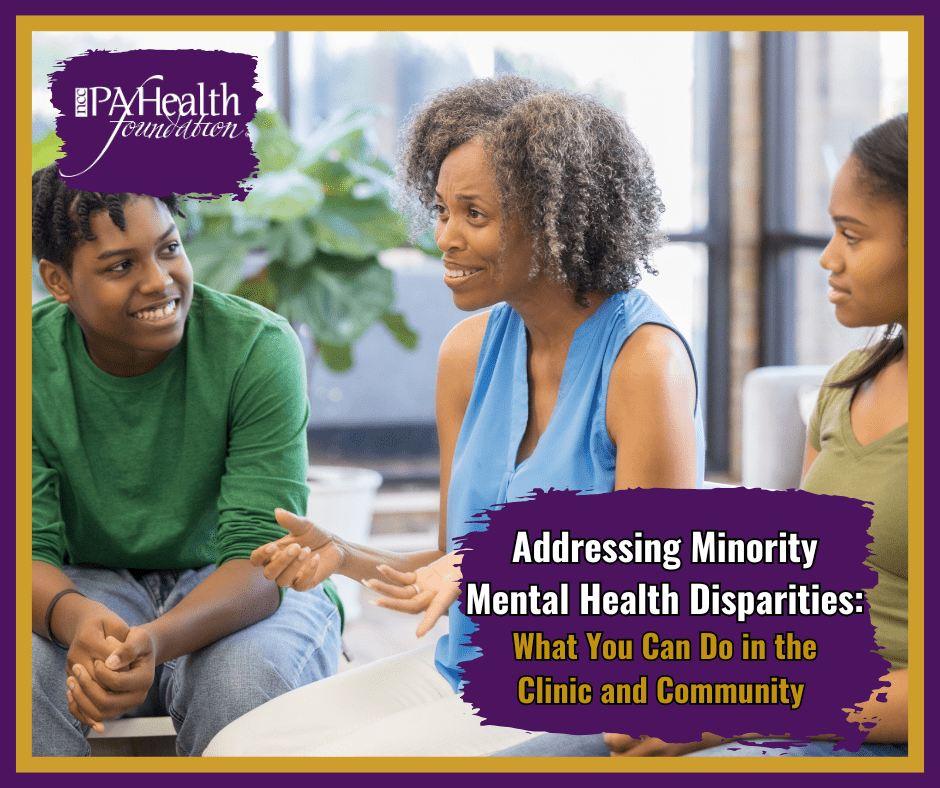Addressing Minority Mental Health Disparities: What You Can Do in the Clinic and Community
Minority populations are often vulnerable, marginalized, underrepresented, and underserved; and they often experience disparities in accessing mental health care. Minority populations include those with disabilities, LGBTQ+ individuals, immigrants, refugees, and racial and ethnic groups such as Black/African Americans, Hispanic/Latino Americans, Asian Americans, Native Americans/Alaska Natives, Native Hawaiians, and Pacific Islanders.
Numerous barriers contribute to underreported and undertreated mental illness and its prolonged effects in these populations. For example, minority groups often face difficulties accessing mental health services and frequently end care prematurely before therapeutic goals are met. Disparities are often attributed to stigma, mistrust of healthcare systems, lack of culturally competent providers, and higher exposure to trauma, discrimination, and socioeconomic stressors.
Here are a few statistics that describe the disparities in mental health care:
- Blacks, Hispanics and American/Indian Native individuals were 1.5 – 2.9x more likely to be uninsured compared to Whites, thus making cost a significant barrier
- Older African Americans may have higher psychological distress from lifelong exposures to racism, discrimination, prejudice, poverty, and violence
- Suicide is the 9th leading cause of death amount American Indian/Alaskan Native People
- LGB Youth attempt suicide at a rate 5X higher than heterosexual youth
- Adults with disabilities are 3X more likely to report suicidal ideation compared to adults without disabilities
- For Black youth between the ages of 10 – 17, the suicide rate increased faster than any other racial group by 144% between the years of 2007 – 2020.
Though the reasons for the increase in suicides and lack of care seeking are varied; for minorities, lack of diversity in providers affects utilization of services. A 2023 Harris Poll conducted by AAPA found that 54% of adults surveyed would feel more comfortable if there is cultural and personal concordance between patient and provider. For Asian, Black, and Hispanic patients, this preference for sociocultural matching rises to 60%.
According to the 2024 Statistical Profile of Board Certified PAs, 33.1% of PAs encounter patients daily that they believe need mental health treatment, which suggests PAs are well positioned to leverage clinical strategies to foster mental health equity:
- Recognize and respond to the distinct challenges faced by identifying obstacles to care and championing change
- Build meaningful connections with patients by cultivating spaces that encourage honest and open dialogue
- Ensure screening is a universal practice, but tailor it using culturally aware, patient-centered methods to effectively support vulnerable populations
- Follow the American Academy of Pediatrics recommendation to conduct suicide risk screening for youth aged 12 and older at routine health visits and when clinically indicated in children aged 8-11
- Be aware of community mental health resources and have readily accessible to patients
- Check out resources in the AAPA Behavioral and Mental Health Toolkit
Collaborating with others can also help decrease inequities. For example, PAs can apply for the nccPA Health Foundation’s outreach grants and build relationships that broaden advocacy and outreach. Local opportunities, such as serving on civic and faith-based boards, participating in programs, and attending festivals, help PAs and other providers connect with those they serve. Leveraging relationships in an unbiased and curious way opens doors for education, support, and treatment. Getting involved at local, state, and national levels amplifies voices and effects change. Collectively, these efforts seek to address and ameliorate the disparities in access to mental health care experienced by minority populations.

For information and resources, visit the following websites:
- AAPA National Health Priority Toolkit: Behavioral & Mental Health
- CDC Minority Health
- Mental Health America
- National Alliance on Mental Illness
References
- Panchal, N. Saunders, H., Ndugga, N. Five Key Findings on Mental Health and Substance Use Disorders by Race/Ethnicity. KFF. Kff.org. September 22, 2022. Accessed May 8, 2025.
- Schatell, E. Challenging Multicultural Disparities in Mental Health. NAMI National Alliance on Mental Illness. July 10, 2017. https://www.nami.org/advocate/challenging-multicultural-disparities-in-mental-health/Accessed May 8, 2025.
- Panchal, N., Hill, L., Artiga, S., Hamel, L. Racial and Ethnic Disparities in Mental Health Care: Findings from the KFF Survey of Racism, Discrimination and Health. KFF. Kff.org. May 23, 2024. Accessed May 8, 2025.
- The Patient Experience: Perspectives on Today’s Healthcare. The Harris Poll. AAPA. aapa.org. Accessed May 22, 2025.
- Mental Health Inequities: Racism and Racial Discrimination. National Alliance on Mental Illness. NAMI.org. Accessed May 22, 2025.
- National Commission on Certification of Physician Assistants, Inc. (2024, July). 2023 Statistical Profile of Board Certified PAs by Specialty: An Annual Report of the National Commission on Certification of PAs. Accessed May 22, 2025, nccpa.net/resources/nccpa-research/
- Still Ringing the Alarm: An Enduring Call to Action For Black Youth Suicide Prevention. Johns Hopkins Bloomberg School Of Public Health. Publichealth.jhu.edu. August 23, 2023. Accessed May 22, 2025.
- Screening for Suicide Risk in Clinical Practice. American Academy of Pediatrics. Aap.org. Updated February 22, 2023. Accessed May 22, 2025.

